Saturday, November 24, 2012
Restored Italian Renaissance Sculptures
View of Lorenzo Ghiberti’s Saint Matthew (1419-1421), as it was installed before conservation at Orsanmichele, Florence, Italy.
Photo credit: Alinari/ Art Resource, NY
Three monumental masterpieces of Italian Renaissance sculpture by Lorenzo Ghiberti, Nanni di Banco, and Andrea del Verrocchio traveled to the National Gallery of Art, Washington, to celebrate the completion of the 21-year restoration of the fourteen exterior monumental sculptures of Orsanmichele, a renowned 14th-century religious and civic center in Florence, Italy.
The exhibition marked the first time that Ghiberti’s Saint Matthew (1419–1421), and Nanni di Banco’s Quattro Santi Coronati (Four Crowned Martyr Saints) (c.1409–1416) traveled outside Florence. In 1993, Verrocchio’s Christ and Saint Thomas (1466–1483) traveled to the Metropolitan Museum of Art for an exhibition marking the completion of its restoration. Monumental Sculpture in Florence: Ghiberti, Nanni di Banco, and Verrocchio at Orsanmichele were on view in the Gallery's West Building, September 18 through February 26, 2006.
Since 1984 the statues from the exterior of Orsanmichele have undergone a much-needed restoration at the prestigious Opificio delle Pietre Dure in Florence—Italy’s premier national restoration center. After painstaking cleaning, the statues have been placed in an interior hall of the church, while replicas are being installed in the original niches on the exterior of the building. Because Orsanmichele has remained closed to the public during this process, the three statues are able to come the National Gallery of Art. After the exhibition in Washington, the sculptures will return to Florence for the public reopening of Orsanmichele.
Saint Matthew by Lorenzo Ghiberti
Lorenzo Ghiberti (1378–1455) cast the first colossal bronze statues since antiquity for Orsanmichele. His talent as a bronze caster was legendary and in 1419 and 1420 the banker’s guild (Cambio) commissioned from him a statue of Saint Matthew. At 8’10” the bronze is a colossus to compete with his earlier Saint John the Baptist, executed for the Banker’s archrivals, the guild of dressers and dyers of foreign cloth (Calimala). In an attempt to outdo his earlier achievement Ghiberti produced one of the most majestic and elegant of all of the statues from Orsanmichele.
Quattro Santi Coronati (Four Crowned Martyr Saints) by Nanni di Banco
Nanni di Banco (c. 1380/1385–1421) was a great sculptor in his own right though his reputation has been overshadowed by the fame of his contemporaries, Donatello and Ghiberti. For the guild of the wood-carvers and stone masons (Maestri di Pietra di Legmame), of which he was a member, Nanni created his most innovative work: the marble group of the four early Christian martyred saints that were the patrons of the guild: the Quattro Santi Coronati. Departing from Ghiberti’s International Gothic style, Nanni’s figures are modeled on Roman statuary and convey the interaction of a real-life group of men caught in an everyday moment, frozen in time. The Quattro Santi Coronati is a key instance of the complex exchange of influences, medieval and antique, that mark this unique moment during the Renaissance.
Christ and Saint Thomas by Andrea del Verrocchio
Verrocchio’s (1435-1488) greatest masterpiece, the Christ and Saint Thomas, was commissioned in 1466 by the Mercanzia, a supervisory organization that regulated the guilds. After a long somewhat contentious gestation, the bronze group consisting of two interlocking figures, Christ and Saint Thomas, was finally unveiled to much acclaim in 1483. Looking back to the Quattro Santi Coronati for the idea of a sculptural group, Verrocchio’s statues break free of their niche with Saint Thomas on the lower outside ledge pushing off his right foot, caught in mid-motion as he moves forward to touch Christ’s wound. For the first time, at Orsanmichele, there was real narrative and dramatic tension: Christ’s open and generous blessing gesture complements and contrasts with Thomas’ active skepticism--well in keeping with the pragmatic spirit of the guilds of Orsanmichele.



